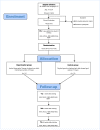Upper limb children action-observation training (UP-CAT): a randomised controlled trial in hemiplegic cerebral palsy
- PMID: 21711525
- PMCID: PMC3141400
- DOI: 10.1186/1471-2377-11-80
Upper limb children action-observation training (UP-CAT): a randomised controlled trial in hemiplegic cerebral palsy
Abstract
Background: Rehabilitation for children with hemiplegic cerebral palsy (HCP) aimed to improve function of the impaired upper limb (UL) uses a wide range of intervention programs. A new rehabilitative approach, called Action-Observation Therapy, based on the recent discovery of mirror neurons, has been used in adult stroke but not in children. The purpose of the present study is to design a randomised controlled trial (RCT) for evaluating the efficacy of Action-Observation Therapy in improving UL activity in children with HCP.
Methods/design: The trial is designed according to CONSORT Statement. It is a randomised, evaluator-blinded, match-pair group trial. Children with HCP will be randomised within pairs to either experimental or control group. The experimental group will perform an Action-Observation Therapy, called UP-CAT (Upper Limb-Children Action-Observation Training) in which they will watch video sequences showing goal-directed actions, chosen according to children UL functional level, combined with motor training with their hemiplegic UL. The control group will perform the same tailored actions after watching computer games. A careful revision of psychometric properties of UL outcome measures for children with hemiplegia was performed. Assisting Hand Assessment was chosen as primary measure and, based on its calculation power, a sample size of 12 matched pairs was established. Moreover, Melbourne and ABILHAND-Kids were included as secondary measures. The time line of assessments will be T0 (in the week preceding the onset of the treatment), T1 and T2 (in the week after the end of the treatment and 8 weeks later, respectively). A further assessment will be performed at T3 (24 weeks after T1), to evaluate the retention of effects. In a subgroup of children enrolled in both groups functional Magnetic Resonance Imaging, exploring the mirror system and sensory-motor function, will be performed at T0, T1 and T2.
Discussion: The paper aims to describe the methodology of a RCT for evaluating the efficacy of Action-Observation Therapy in improving UL activity in children with hemiplegia. This study will be the first to test this new type of treatment in childhood. The paper presents the theoretical background, study hypotheses, outcome measures and trial methodology.
Trial registration: NCT01016496.
Figures
References
-
- Uvebrant P. Hemiplegic cerebral palsy: aetiology and outcome. Acta Paediatr Scand. 1988;345:1–100. - PubMed
-
- Himmelmann K, Hagberg G, Beckung E, Hagberg B, Uvebrant P. The changing panorama of cerebral palsy in Sweden. IX. Prevalence and origin in the birth-year period 1995-1998. Acta Paediatr. 2005;94(3):287–294. - PubMed
-
- Cioni G, Sgandurra G, Muzzini S, Paolicelli PB, Ferrari A. In: The spastic forms of cerebral palsy A guide to the assessment of adaptive functions. Ferrari A Cioni G, editor. Milan: Springer-Verlag; 2009. Forms of hemiplegia; pp. 331–353.
Publication types
MeSH terms
Associated data
LinkOut - more resources
Full Text Sources
Medical
Miscellaneous



